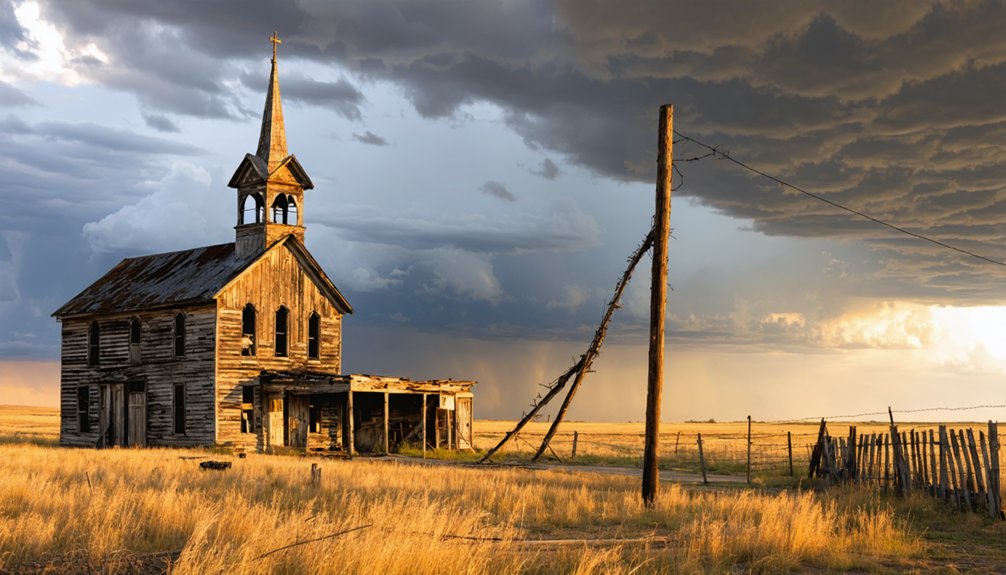You’ll find Grandview’s ghost town remnants in Douglas County, South Dakota, where it once thrived as the county seat in 1882. Dutch immigrants made up half the population, creating a unique cultural enclave divided between Upper and Lower Grandview. The town bustled with county offices, businesses, and a newspaper until losing its seat status in 1886. While most wooden structures have vanished, scattered foundations hint at stories of frontier ambition, political rivalries, and pioneer determination.
Key Takeaways
- Grandview was established in 1873 as Douglas County’s third seat, flourishing briefly as a metropolis with county offices and businesses.
- Dutch immigrants made up over half the population, creating a divided community between Upper and Lower Grandview sections.
- The town lost its county seat status to Armour in 1886, triggering economic decline and eventual abandonment.
- Transportation failures and inability to diversify beyond government functions led to Grandview’s transformation into a ghost town.
- Today, only scattered foundational remnants remain, including the courthouse-store and post office structures.
The Rise of a County Seat
When Dakota Territory’s legislature established Douglas County in 1873, they’d set in motion events that would shape the region’s early development.
The establishment of Douglas County in 1873 marked a pivotal moment that would forever alter Dakota Territory’s frontier landscape.
You’ll find the settlement dynamics of this prairie frontier were initially chaotic, with fraudulent attempts to organize local government marking the county’s earliest days.
After the legislature nullified these questionable efforts, they finally got things right in 1882. That’s when Grandview, near present-day Corsica, emerged as the county’s third seat, establishing proper legal foundations for the area.
You’d have seen the town quickly transform into what locals called a “metropolis,” as county offices, businesses, and civic services sprouted up to serve the sparsely populated region.
The presence of government institutions attracted professionals, merchants, and settlers, all enthusiastic to stake their claim in this promising new center of prairie life.
The Foster-Devy store served as the temporary courthouse for twelve years, handling all official county business during Grandview’s time as the seat of government.
Today, with a population of six, Grandview stands as a testament to the dramatic changes that can befall frontier settlements.
Political Power Struggles in Douglas County
You’ll find echoes of fierce political battles in Douglas County’s history, where Grandview’s quest for county seat status pitted neighbor against neighbor through heated campaigns and contentious public meetings.
The town’s supporters leveraged their connections with Dutch immigrant colonies and agricultural interests to build a formidable voting bloc, while opposing towns marshaled their own political alliances through land ownership patterns and community organizations. The early pioneers documented in South Dakota Tales captured the intensity of these local political struggles.
When the final votes were tallied in a nail-biting finish, Grandview’s narrow victory reshaped local power dynamics for decades to come.
County Seat Battle Details
Though Grand View initially held prominence as Douglas County‘s first seat of power in 1882, a fierce political battle would ultimately reshape the region’s destiny.
Situated between the James and Missouri rivers, the scenic prairie location made Grand View an attractive choice for the original county seat.
As the county grew, you’d witness Armour emerge as a formidable challenger in the early 1890s, engaging in shrewd political maneuvering to claim the coveted county seat title.
The battle centered around several key factors:
- Armour’s strategic promise to build a new courthouse in 1894
- The Milwaukee Road railroad’s influential presence in Armour
- Grand View’s declining importance as a transportation hub
- Shifting population demographics favoring Armour’s location
By 1889, Armour had become a major transportation hub with eight trains daily, strengthening its position in the county seat battle.
The contest reached its climax when Armour’s courthouse promise proved decisive.
You can still trace how this political power shift transformed Grand View from a thriving administrative center into a ghost town, while Armour flourished as the new county capital.
Competing Towns’ Political Moves
The political landscape of Douglas County in the 1880s resembled a high-stakes chess match, with multiple towns vying for dominance and influence. You’d find political alliances shifting as rival townships deployed every trick in their arsenals.
The Democratic-leaning Douglas County Chronicle wielded significant influence until its relocation to Armour in 1886, while Governor Ordway’s support of Huston added fuel to the fire.
In this territorial power play, you’d see Robert Dollard allegedly distributing beer to secure votes for Grand View, while Armour strategically promised to build a courthouse to lure the county seat in 1894. Like the characters in small-town drama portrayed in the 1984 film “Grandview, U.S.A.,” local leaders fought passionately for their community’s survival.
Even Grand View itself split into “Upper” and “Lower” factions, reflecting the deep political divisions that would ultimately reshape Douglas County’s future.
Meanwhile, smaller towns like Maitland and Douglas City faded into obscurity.
Narrow Victory’s Lasting Impact
When Grandview clinched its position as Douglas County’s third county seat in 1882, few could’ve predicted how this narrow victory would reshape the region’s political landscape for decades to come.
Ghost towns like Grandview required patient searching by historians to accurately document their existence and decline.
Similar to how railroads influenced development, many towns in South Dakota rose and fell based on their strategic importance to transportation and commerce.
The intense political rivalry that emerged would ultimately seal the town’s fate, leading to its dramatic economic decline and eventual abandonment by 1886.
You’ll find that the victory’s lasting impact manifested in several critical ways:
- Deep community divisions emerged, hampering cooperative development across Douglas County
- Political power shifts triggered mass relocations as residents chased opportunity
- The town’s infrastructure deteriorated once it lost its county seat status
- Local businesses shuttered, transforming Grandview into a cautionary tale of frontier boom-and-bust cycles
This power struggle left an indelible mark on South Dakota’s territorial development, showing how political fortunes could make or break frontier communities.
Life in Early Grandview Settlement
Pioneer life in Grandview began taking shape in 1883 as white settlers, including William Floyd and the Still brothers, established their homes in what would become a thriving settlement of 600 residents by 1885.
You’d find a distinct division between Upper and Lower Grandview, creating a spirited local rivalry that shaped the community’s character.
Despite pioneer challenges like sandstorms and crude roads, settlers built homes from whatever they could find – rough boards, sod, and lumber hauled from Kimball.
The Dutch immigrants, making up over half the population, held onto their language while adapting to frontier life.
You’d see the community’s resilience in their early institutions – a post office, church, and newspaper – which became essential gathering places.
Until the railroad’s arrival in 1907, you’d have to transport goods by team and ferry to nearby towns.
Economic Forces Behind the Town’s Development
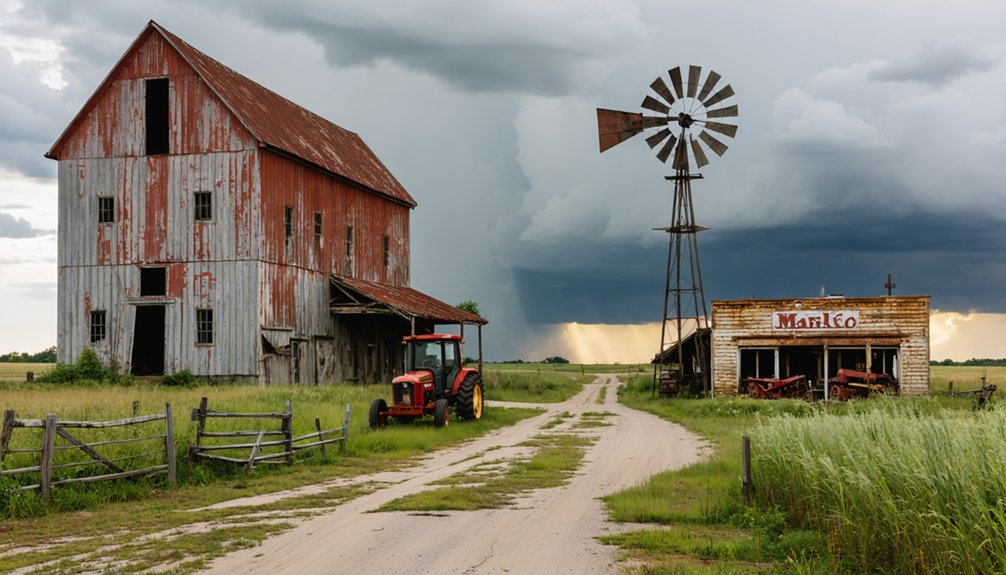
Mining transformed Grandview from a modest settlement into a bustling economic hub during the late 1880s, as prospectors discovered rich gold deposits in nearby gulches.
You’ll find that railroad significance played an essential role, with the Deadwood Central and Chicago North-Western lines connecting this ambitious town to critical markets.
Mining impacts rippled through every aspect of life, creating a web of economic activity that shaped Grandview’s destiny.
- Gold processing operations drew railroads, workers, and supporting businesses
- County seat status brought government jobs and administrative stability
- Local merchants and services flourished, serving both miners and railroad workers
- The Douglas County Chronicle newspaper reflected the town’s growing prosperity
The town’s fortunes remained tightly bound to its mining roots, though, and when the gold began to fade, so did Grandview’s economic might.
Daily Routines of Pioneer Residents
Life in Grandview revolved around the rhythms of agriculture and community bonds, as residents balanced demanding farm work with rich social connections. Early mornings often started with trips to the grain elevator for farmers managing their harvests.
The Turning Point and Decline
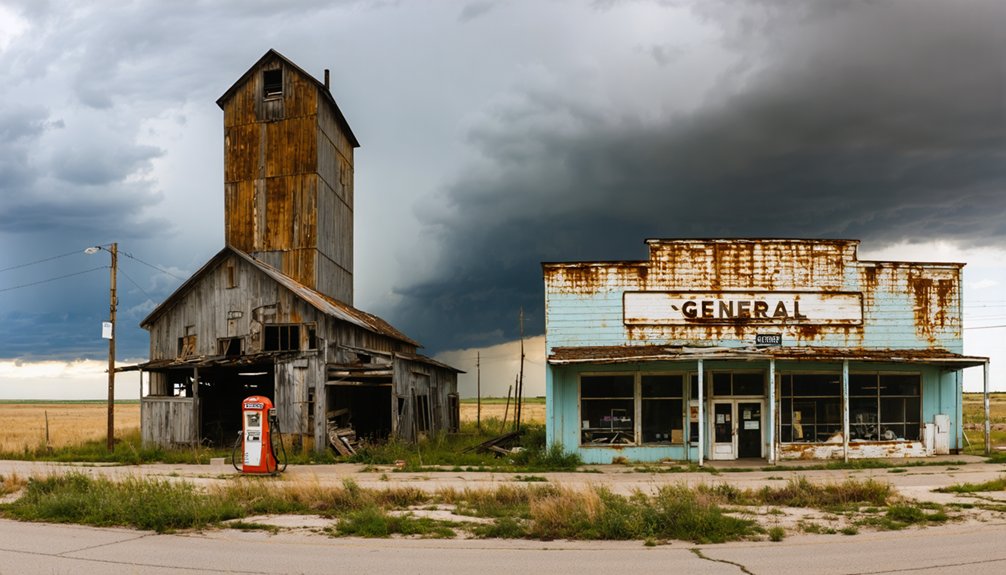
While prosperity initially defined Grandview’s early years as Douglas County’s third seat in 1882, the winds of change would soon sweep through this promising metropolis.
You’ll find that transportation failures and economic vulnerabilities quickly unraveled the town’s bright future after 1886. The loss of the county seat status dealt a devastating blow, exposing the fragile nature of Grandview’s administrative-dependent economy. Like many towns that followed the Black Hills Rush in 1876, Grandview struggled to maintain its economic footing.
The promising frontier town of Grandview crumbled after losing its county seat status, revealing an economy too dependent on government operations.
The town’s decline accelerated due to several crucial factors:
- Failure to secure essential railroad connections left the town isolated
- Inability to diversify beyond government functions
- Competition from better-positioned neighboring communities
- Shifting regional dynamics, including the decline of Black Hills mining
The automotive age’s arrival only hastened Grandview’s fate, and you’ll now find little more than foundations where this once-bustling town stood.
Architectural Legacy and Physical Remains
As time and nature have reclaimed Grandview’s remains, you’ll find only scattered traces of the once-bustling frontier town that crowned the hilltop in 1882.
The town’s architectural adaptations reflected its unique split personality – Upper Grandview perched proudly on the hill while Lower Grandview nestled in the southern hollow, creating a distinctive divided settlement that shaped daily life.
You can still spot the foundational remnants where key community structures once stood: the combination courthouse-store on the east side, the post office, and the church.
These wooden-frame buildings, built for function rather than flair, succumbed to the harsh Black Hills weather over time.
Today, the weathered ruins and minimal masonry traces offer quiet testimony to the frontier spirit that once animated this remote outpost.
Notable Characters and Local Stories
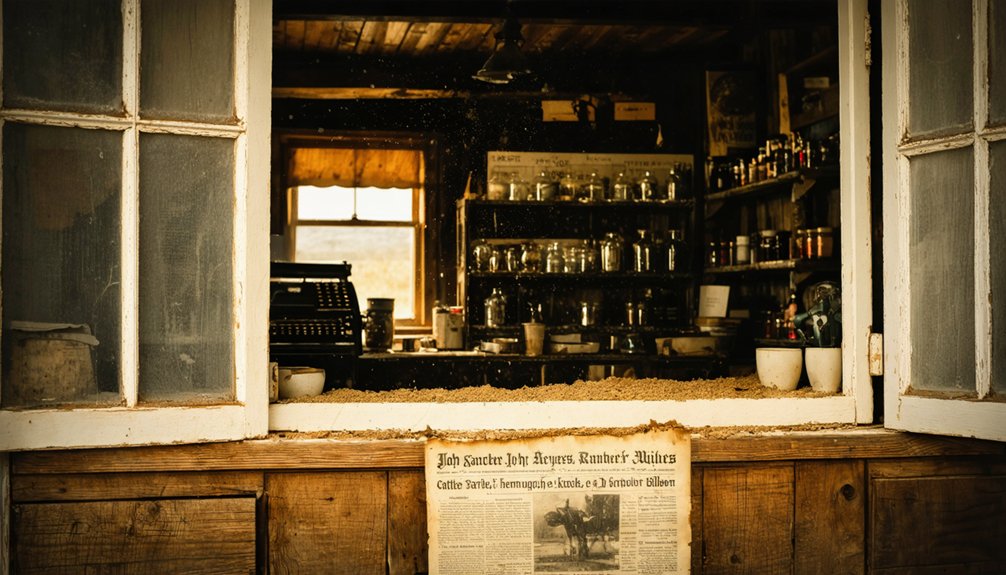
Beyond the weathered foundations and fading structures, the true spirit of Grandview lives on through the colorful characters who once called this Black Hills settlement home.
The mining legends and community folklore paint a vivid picture of life in this frontier town, where miners, entrepreneurs, and local officials shaped the community’s identity during its brief reign as Douglas County’s third seat.
Tales of rugged miners and ambitious settlers echo through time, shaping the brief but vibrant legacy of this Black Hills frontier town.
- Early settlers established bustling bars and grills that became the heartbeat of local social life.
- Miners and railroad workers formed the backbone of the town’s economic significance.
- Mining widows left their mark on local lore, with their stories echoing through abandoned cabins.
- County officials and judges brought administrative prominence during the town’s heyday as a county seat.
These characters’ stories continue to captivate visitors and historians, preserving Grandview’s legacy in the tapestry of Black Hills history.
Mapping the Ghost Town Today
Despite the passage of time, modern visitors can still pinpoint Grandview’s exact location through careful mapping and remaining physical markers. You’ll find this ghost town mapping exercise leads you to the intersection of 392nd Avenue and 276th Street in Douglas County, where a historical marker stands at 43°23′03″N latitude and 98°21′19″W longitude.
Site accessibility remains straightforward via rural roads, though you won’t see many original structures left standing.
The town site, split between Sections 13 and 24 of Grandview Township, has mostly returned to pastureland. While most buildings have vanished or relocated to nearby towns like Armour, foundation remnants and the marker’s detailed town map help you piece together Grandview’s original layout, offering a window into its past.
Preserving Grandview’s Historical Memory
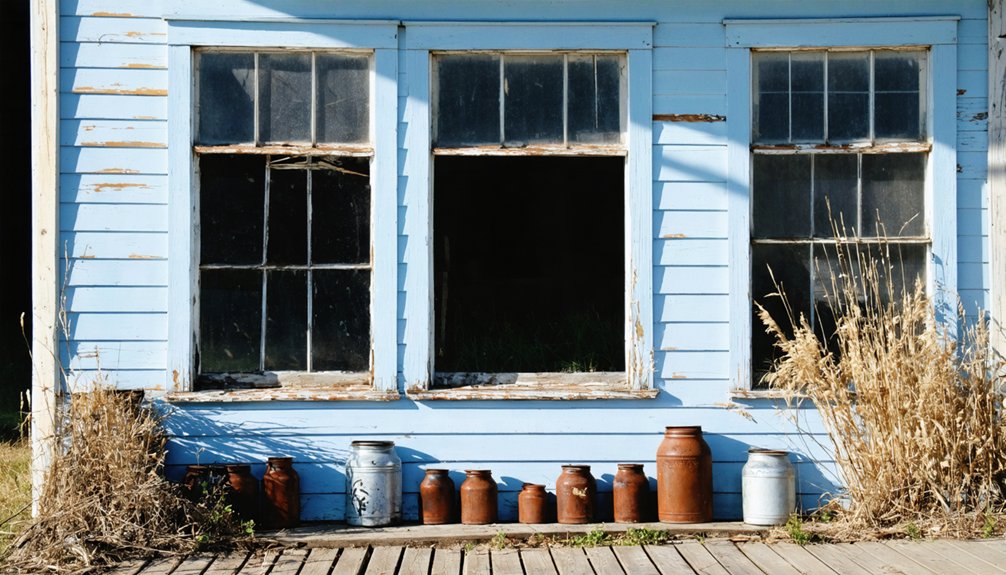
You’ll find Grandview’s legacy preserved through the South Dakota State Historical Society‘s extensive collection of maps, deeds, and the personal papers of Will G. Robinson, who documented the town’s rise and decline.
Local historical societies work tirelessly to gather oral histories and photographs from former residents and their descendants, ensuring these precious memories aren’t lost to time.
The physical site itself now stands protected under state preservation guidelines, with clear signage marking its historic significance and controlled access measures helping safeguard what remains of this once-thriving community.
Historical Records Collection
The South Dakota State Archives stands as the primary guardian of Grandview’s historical memory, housing thousands of invaluable records since its establishment in 1975.
This treasure trove of archival significance contains detailed accounts of the town’s evolution, carefully preserved within the Cultural Heritage Center since 1989.
You’ll find these essential historical records encompassing Grandview’s story:
- Original military service reports and muster rolls dating from 1883-1891
- “Report and Historical Collections” series documenting township foundations and political shifts
- Government records detailing post office operations and mail routes
- Digitized databases and indexes accessible through online platforms like FamilySearch
These historical preservation efforts guarantee that Grandview’s legacy lives on through meticulously maintained documents, allowing you to trace your connections to this fascinating ghost town’s past.
Documenting Local Stories
While official records tell part of Grandview’s story, it’s through the vivid memories and cherished tales of local residents that the town’s true spirit lives on.
You’ll find the town’s rich oral traditions woven through resident interviews, where local legends and personal anecdotes paint a more intimate portrait than any dusty document could provide.
Physical Site Protection
Preserving physical remnants of Grandview’s past requires a dedicated blend of legal protection and community stewardship. The South Dakota State Historic Preservation Office oversees site preservation efforts through historical markers and protection programs that keep this cherished piece of prairie history intact for future generations.
- The National Historic Preservation Act provides essential legal safeguards against development, ensuring Grandview’s historical significance remains protected.
- Local community involvement drives ongoing preservation through educational initiatives and maintenance efforts.
- Historical markers serve as visual anchors, helping visitors understand Grandview’s original layout.
- Private property considerations require careful coordination with landowners to maintain appropriate access and preservation.
You’ll find that successful preservation relies on balancing public interest with private rights, creating a sustainable approach to protecting Grandview’s physical legacy while respecting property boundaries.
Frequently Asked Questions
What Natural Disasters or Extreme Weather Events Affected Grandview’s History?
You’d be shocked, but there’s no record of major disasters hitting! While harsh Black Hills winters, occasional flood damage, and drought impact were common challenges, no single catastrophic event sealed Grandview’s fate.
Were There Any Significant Native American Interactions With Grandview’s Early Settlers?
You’ll find that Native American relations around Grandview were mostly tense, with Lakota tribes resisting settler expansion through raids. There wasn’t much peaceful cultural exchange between the two groups.
Did Grandview Have a Railroad Connection During Its Peak Years?
Picture a dusty trail where railroad tracks should’ve been. You won’t find any rail connections in Grand View during its peak – this missing transportation route sealed the town’s fate, impacting its survival chances.
What Churches or Religious Organizations Existed in Early Grandview?
You won’t find records of a Baptist Church or Lutheran community in early days there – folks gathered informally in homes and outdoor spaces, with visiting preachers serving their spiritual needs.
Were There Any Notable Crimes or Law Enforcement Challenges in Grandview?
Like hitting a 404 error, you won’t find much on crime rates in town. Historical records don’t reveal any notable law enforcement challenges during Grandview’s brief stint as county seat.
References
- https://www.youtube.com/watch?v=Glucs_Rq8Xs
- https://www.sdpb.org/rural-life-and-history/2023-08-21/some-black-hills-ghost-towns-and-their-origins
- https://www.sdhspress.com/journal/south-dakota-history-2-2/some-black-hills-ghost-towns-and-their-origins/vol-02-no-2-some-black-hills-ghost-towns-and-their-origins.pdf
- https://core.ac.uk/download/pdf/345016075.pdf
- https://www.youtube.com/watch?v=_0WNYsFLSLA
- https://en.wikipedia.org/wiki/List_of_ghost_towns_in_South_Dakota
- https://www.hmdb.org/m.asp?m=180686
- https://grantcounty.sd.gov/mobile/information/aboutgrantcounty.php
- http://files.usgwarchives.net/sd/ethnic/dutch/lxxxviii.txt
- https://www.sdhspress.com/journal/south-dakota-history-41-1/cumulative-index/cumulative-index-web-copy.pdf
